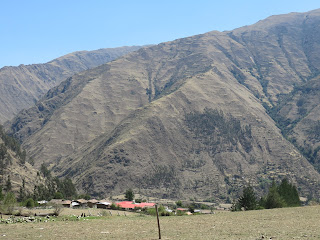It was my first solo-travelling trip (you'd think I ought to be able to manage now after a year) so I found the little bus station that goes to the Circa area and bought my ticket, shared the seat with a couple of chatty old ladies and bounced along the track to Taccacca, where I had never been before.
Taccacca has been targeted by a new government programme as it's in the lowest percentile for extreme poverty. So they are receiving a project to repair and replace elements of their water system. Yesela's job is to deliver the community teaching programme that goes along with the project.
Here's the washing and bathroom facilities where we were staying, to give you an idea.
We had a meeting with the village leaders (the community president, the water committee, the health workers and teachers) to agree the programme for the different teaching sessions. First we worked out the rough plan in our room / office. Sessions include writing an annual plan for water system maintenance and purchase of chlorine, to determine how much each family should pay, then a session on health and hygiene, another on basic plumbing... and much more.
Then we agreed the plan with the leaders - it's hard to fit everything in because people spend basically all the daylight hours working on their farmland - and planting season is coming up so it's only going to get busier. We can have evenings and occasional weekend days, but we also need to give people a chance to rest! The next day we walked up to the reservoir with the health worker and 2 men from the water committee, to disinfect the reservoir. This is meant to be done at least every 6 months.
First you empty it (this involve me looking at the different pipes and valves and working out which was which - I've drawn them a diagram now showing what's what, and which ones should be open/closed, so they'll know for the future) then you clean it with water and scrubbing brushes, and rinse it out.
Then it's time to fill it up, give it a heavy dose of chlorine, and leave it to soak. While it filled up I measured the water level over time - a good way to figure out how much water is arriving.
The Taccacca reservoir has the equipment to chlorinate the water consistently - which is Peru's big push at the moment to improve water quality. So after we'd rinsed the tank out again we got the dosing system working. One problem is that the reservoir is always full to overflowing, which is a waste of lots of the chlorine (and an unnecessary expense). So I'll be talking to them about different ways they can solve this issue.
Mixing chlorine solution which drips steadily from the plastic tank into the reservoir
And some nice views on the way back down to the village:
We managed to finish everything needed for Yesela's deadline next week, so it was great to have been useful. We talked a lot about her plans for the health and hygiene teaching as well, and I passed on lots of ideas and materials from my work in Ecuador that she is looking forward to using.
I'll be going back!




































